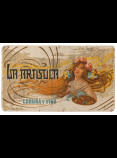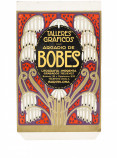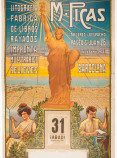The triumph of image in colors

La Artística. Tin. La Artística, La Corunya-Vigo, c.1900. Col. Mateu Llinàs i Audet. Photo: Frederic Camallonga

Talleres gráficos Arcadio de Bobes. Cardboard. Barcelona, c. 1920. Col. Mateu Llinàs i Audet. Photo: Frederic Camallonga

Calendar. Litografía M. Picas. Barcelona, 1900. Cardboard. Col. Mateu Llinàs i Audet. Photo: Frederic Camallonga
The industrial revolution, advertising and chromolithography are inseparable. The attraction of commercial advertising became a reality thanks to adverts full of colour, soon considered to be “street art”. Paper and tin proved to be useful materials.
Lithography (from the Greek lithos –stone– and graphos –drawing–), was invented by the Bavarian Aloys Senefelder in 1796, and is based on the incompatibility of water with fat-based materials. The image was drawn directly on to polished, porous limestone (and from 1895 onwards, zinc sheets) using pencils or fat-based ink. It was then washed with nitric acid and prepared with a composition of gum arabic and water which only penetrated the drawn image. When inked, the wet areas repelled the ink, which would only stick to the image, and when pressed the image was transferred onto paper.
Chromolithography, which was widely used until 1950, required as many stone slabs as there were colours in the drawing (each one with the pattern for each colour) and all of them then had to be superimposed with precision, keeping the same register, in order to achieve the proper result. The resulting image was immediately lacquered to protect it and make it shiny. Metal posters were made in relief by pressing the metal. The first factories producing metal containers printed with chromolithography began to appear at the end of the 19th century, In Catalonia, an Italian company, founded by Gottardo de Andreis in 1860, stands out. In 1905 he opened a branch in Badalona, popularly known as La Llauna, which produced many of the exhibited posters, followed by others, as happened throughout Spain.



